Carbon Sensing Applications
-
- Advancing Climate Change Research and Hydrocarbon Leak Detection Marine Technology, Mar 2013 #18
By Combining Dissolved Carbon Dioxide and Methane Measurements with ADCP Data.
With the emergence of large-scale, comprehensive environmental monitoring projects, there is an increased need to combine state-of-the art technologies to address complicated problems such as ocean acidification and hydrocarbon leak detection.
Carbon is a building block of life on earth and is a key element of many ocean chemical processes. The ability to measure dissolved carbon dioxide (CO2) and methane (CH4) in the ocean is beneficial for a wide variety of oceanographic and limnological applications. Recently, there has been an increased demand for two specific carbon sensing applications: one for researching the effects of climate change on the ocean environment and another for operational use in the oil and gas industry. Sensing of dissolved CO2 allows for better quantification of the global carbon cycle and understanding how increased levels of dissolved carbon dioxide in the atmosphere affect the oceanic carbon budget, the resulting acidification of the oceans, and the corresponding influence on marine organisms and habitat. Sensing dissolved CH4 in oceans or lakes allows one to find regions of elevated concentrations fed by naturally occurring hydrocarbon seeps, melting methane hydrate bearing permafrost, or potential leaks from an oil and gas well, production facility, or pipeline.
Teledyne Marine has recently licensed technology developed by CONTROS GmbH to produce the HydroCO2 and HydroCH4 instruments and allow its customers to better address their bio-geochemical as well as oil and gas-related applications.
Combining carbon dioxide and/or methane concentration data with the physical oceanographic parameters measured with Teledyne RD Instruments’ Acoustic Doppler Current Profilers (ADCPs) and Conductivity Temperature and Depth (CTD) sensors will allow improved understanding of biogeochemical processes as a function of ocean temperature, salinity, mixing, and advective transport. Integration of the ADCP current profiles and volumetric transport information with the dissolved gas readings from the HydroCO2 and HydroCH4 systems will also improve the utility of hydrocarbon leak detection programs by allowing users to backtrack the “up current” to identify the source of the seep or leak.
Facilitating and expanding data collection will be accomplished by integrating the HydroCO2 and HydroCH4 in-situ sensor technologies with other Teledyne Instruments, Inc. product offerings. Examples are the Teledyne Benthos, Teledyne Webb Research, and Teledyne Gavia tethered, towed, and autonomous vehicles. The HydroCH4 sensor may be combined with the Teledyne TSS Pipe Detection system via the Mobile Early Leak Detection System (MELDS) for detecting the presence of hydrocarbons in water.
The HydroCO2 and HydroCH4 products utilize a flat hydrophobic membrane that forms a semi permeable phase boundary between full ocean depth pressures and the interior of the instrument. Dissolved gasses in the water pass into an equilibrated internal headspace in the form of a gas stream. Concentration of CO2 or CH4 in the gas stream is quantified using an industry standard non-dispersive infrared detector (NDIR-detector) and the principle of absorption spectrometry (1). To overcome the temperature dependency of the NDIR sensors, the detector is temperature stabilized and the gas is lead through a heater before entering the NDIR unit both during initial instrument calibration as well as during operation in the field. To compensate for the long term drift of the sensor, a “zero point” reference is routinely taken by the NDIR-detector within the instrument after the air within the gas stream has been chemically freed from CO2 or CH4. This zero reference data can be used to track the temporal signal drift of the NDIR-detector and allows for the derivation of the sensor’s actual response time (2).
The HydroCO2 and HydroCH4 physical packaging allows for a wider range of deployment possibilities than previously available with existing dissolved CO2 and CH4 measurement systems. When configured as a flow through system inside of a vessel or within a laboratory, these instruments have a significantly reduced maintenance effort and smaller size than prevailing underway systems that use large equilibration chambers and bottles of reference gasses. Use of the HydroCO2 and HydroCH4 systems enable deployment from smaller vessels, adding a valuable measurement parameter while reducing the energy and space requirements (e.g., less room occupied in a vessel’s wet lab). When configured as a self-contained submersible system, the systems will operate from water surface to 6000m of depth. The 9 cm diameter pressure housing on the system allows for easy deployment on buoys, moorings, AUV’s, gliders and Argo floats (2 and 3). Example of a bottom lander deployment combining an ADCP and the HydroCH4 sensor is shown here.
Instruments for Loan:
Apply Before April 15!
Teledyne RD Instruments is confident that these carbon sensors will aid in both scientific research and environmental monitoring. Through a newly established product grant program, Teledyne RD Instruments will offer the loan of up to 3 instruments – one each of either a HydroCO2, a HydroCH4 senor, a WH/OS ADCP, or Citadel CTD system – for new and interesting applications utilizing these combined technologies.
Users are encouraged to submit detailed proposals on how they would utilize these products to improve their scientific research or environmental monitoring.
Full details and an online submission form can be accessed at
www.rdinstruments.com. Proposals are due on or before April 15, 2013.References
(1) Fietzek, P. & Körtzinger, A. (2010) Optimization of a membrane based NDIR-Sensor for Dissolved Carbon Dioxide. In Proceedings of “OceanObs’09: Sustained Ocean Observations and Information for Society” Conference (Annex), Venice, Italy, 21-25 September 2009, Hall, J., Harrison D.E. & Stammer, D., Eds., ESA Publication WPP-306.
(2) Fiedler, B., Fietzek, P., Vieira, N., Silva, P., Bittig, H.C. and Körtzinger, A. (2013): In situ CO2 and O2 measurements on a profiling float, Journal of Atmospheric and Oceanic Technology, 30 . pp. 112-126.
(3) Fietzek, P., Kramer, S. & Esser, D. (2011) Deployments of the HydroC (CO2/CH4) on stationary and mobile platforms – Merging trends in the field of platform and sensor development. In Proceedings of Oceans 2011 conference (USA, September 2011).
(4) Deployment photo courtesy of Dr. Peter Linke, GEOMAR http://www.geomar.de/index.php?id=plinke.
(As published in the March 2013 edition of Marine Technologies - www.seadiscovery.com)
-
 )
March 2024 - Marine Technology Reporter page: 48
)
March 2024 - Marine Technology Reporter page: 48Index page MTR MarApr2024:MTR Layouts 4/4/2024 3:19 PM Page 1 Advertiser Index PageCompany Website Phone# 17 . . . . .Airmar Technology Corporation . . . . . . . . . .www.airmar.com . . . . . . . . . . . . . . . . . . . . . . . . . . . . . . . . .(603) 673-9570 9 . . . . . .Birns, Inc. . . . . . . . . . .
-
 )
March 2024 - Marine Technology Reporter page: 45
)
March 2024 - Marine Technology Reporter page: 45and Solus- XR platforms will be equipped with Cellula’s hydrogen fuel cell technology, supporting sustainable, long duration operations with zero carbon emissions • Teledyne Marine Acquires Valeport Teledyne Marine agreed to acquire Valeport a leader in the design and manufacture of underwater sensors
-
 )
March 2024 - Marine Technology Reporter page: 44
)
March 2024 - Marine Technology Reporter page: 44NEW TECH OCEANOLOGY INTERNATIONAL 2024 Image courtesy Metron/Cellula Teledyne Marine acquires Valeport: Matt Quartley, MD, Valeport and Ole Søe-Pedersen, VP & Image courtesy Teledyne Marine GM Teledyne Marine announce the deal in London. Pictured (L-R): Cellula Robotics, President, Eric Jackson, Metron
-
 )
March 2024 - Marine Technology Reporter page: 36
)
March 2024 - Marine Technology Reporter page: 36in the Mariana Trench. The sail is to the left, the keel is to the right. The starboard side PBOF LiPo battery packs are located behind a clear polycarbonate panel mid- body above the thrusters. A second identical set of batteries is located on the port side of the vehicle. Individual battery packs
-
 )
March 2024 - Marine Technology Reporter page: 35
)
March 2024 - Marine Technology Reporter page: 35Figure 1 A self-righting vehicle design with buoyancy high and weight low, WHOI’s SeaBED AUV captures the attention of a pair of curious Antarctic penguins as it is deployed from the British research vessel James Clark Ross. Vehicle designers allowed for temperature reduction of battery capacity. Recharge
-
 )
March 2024 - Marine Technology Reporter page: 34
)
March 2024 - Marine Technology Reporter page: 34LANDER LAB #10 BATTERY PACKS, CHARGING, AND CAPACITY TESTING Photo Credit: Hanumant Singh / Woods Hole Oceanographic Institution. By Kevin Hardy, Global Ocean Design LLC n ocean lander has many strengths including that produces the current is irreversible. Examples include ? exibility of deployment
-
 )
March 2024 - Marine Technology Reporter page: 29
)
March 2024 - Marine Technology Reporter page: 29help meet the world’s spiraling demand for met- als,” says GSR managing director Kris Van Nijen. “Our focus is on developing a source of high grade, low carbon minerals which can work alongside other strategies to reach the eventual goal of a circular economy and a stable planet.” Canada-based The Metals
-
 )
March 2024 - Marine Technology Reporter page: 25
)
March 2024 - Marine Technology Reporter page: 25Auerbach explained that ideally, “one ? ed layers of geothermal activity,” noted changes over an area of 8,000 km2. They would have both instruments: seismom- Skett, “and the change in salinity and dis- found up to seven km3 of displaced ma- eters to detect and locate subsurface ac- solved particles for
-
 )
March 2024 - Marine Technology Reporter page: 15
)
March 2024 - Marine Technology Reporter page: 15sensor options for longer mission periods. About the Author For glider users working in ? sheries and conservation, Shea Quinn is the Product Line Manager the Sentinel can run several high-energy passive and active of the Slocum Glider at Teledyne Webb acoustic sensors, on-board processing, and imaging
-
 )
April 2024 - Maritime Reporter and Engineering News page: 48
)
April 2024 - Maritime Reporter and Engineering News page: 48Index page MR Apr2024:MN INDEX PAGE 4/5/2024 1:33 PM Page 1 ANCHORS & CHAINS MILITARY SONAR SYSTEMS tel:+44 (0) 1752 723330, [email protected] , www.siliconsensing.com Anchor Marine & Supply, INC., 6545 Lindbergh Houston, Massa Products Corporation, 280 Lincoln Street, SONAR TRANSDUCERS
-
 )
April 2024 - Maritime Reporter and Engineering News page: 43
)
April 2024 - Maritime Reporter and Engineering News page: 43tection. The work would also demand a regulations to help digitalization nurture scaling-up of solutions. review of SOLAS formulations for the decarbonization. New energy saving devices, alterna- design, planning and testing of ships, “I don't say that crews must be soft- tive fuels, carbon capture
-
 )
April 2024 - Maritime Reporter and Engineering News page: 42
)
April 2024 - Maritime Reporter and Engineering News page: 42OPINION: The Final Word Seeing the Ship as a System Shipping must engage with the decarbonization realities that lie ahead by changing the way it crafts maritime legislation to re? ect its place in the interconnected, interdependent world economy, said Eero Lehtovaara, ABB Marine & Ports. ABB Marine &
-
 )
April 2024 - Maritime Reporter and Engineering News page: 41
)
April 2024 - Maritime Reporter and Engineering News page: 41Nautel provides innovative, industry-leading solutions speci? cally designed for use in harsh maritime environments: • GMDSS/NAVTEX/NAVDAT coastal surveillance and transmission systems • Offshore NDB non-directional radio beacon systems for oil platform, support vessel & wind farm applications
-
 )
April 2024 - Maritime Reporter and Engineering News page: 38
)
April 2024 - Maritime Reporter and Engineering News page: 38, and oil gt, was moored using the 3-ton pulling capacity of the moor- spill response services. Images courtesy Consulmar Crowley's New LNG Containerships Carbon Capture @ Sea Crowley shared ? rst renderings and the names of its four new dual fuel lique? ed natural gas (LNG)-powered containerships: Quetzal
-
 )
April 2024 - Maritime Reporter and Engineering News page: 16
)
April 2024 - Maritime Reporter and Engineering News page: 16MARKETS SOVs – Analyzing Current, Future Demand Drivers By Philip Lewis, Director of Research, Intelatus © Björn Wylezich/AdobeStock t a high-level, there are three solutions to transferring Lower day rate CTVs are often used for daily transfer of technicians from shore bases to offshore wind farms
-
 )
April 2024 - Maritime Reporter and Engineering News page: 13
)
April 2024 - Maritime Reporter and Engineering News page: 13that is a pointless exercise. It would actually make more cal sequence: sense to buy a plug-in hybrid that is con? gured for methanol It is the carbon. We want zero carbon as soon as possible. 1. IC, but, unfortunately, no such cars are being produced today. A Focus on sustainable electricity generation
-
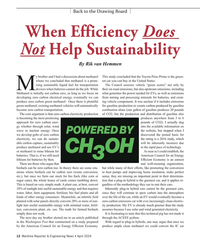 )
April 2024 - Maritime Reporter and Engineering News page: 12
)
April 2024 - Maritime Reporter and Engineering News page: 12not only by Mdevices when batteries cannot do the job. While their on-road emissions, but also upstream emissions, including Methanol is initially not carbon zero, as long as we focus on what generates the power needed for EVs, as well as emissions developing zero carbon electrical energy, eventually we
-
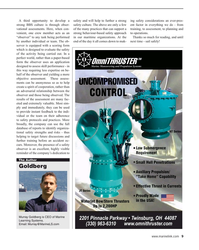 )
April 2024 - Maritime Reporter and Engineering News page: 9
)
April 2024 - Maritime Reporter and Engineering News page: 9A third opportunity to develop a safety and will help to further a strong ing safety considerations an ever-pres- strong BBS culture is through obser- safety culture. The above are only a few ent factor in everything we do - from vational assessments. Here, when con- of the many practices that can
-
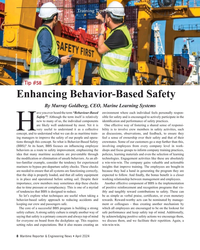 )
April 2024 - Maritime Reporter and Engineering News page: 8
)
April 2024 - Maritime Reporter and Engineering News page: 8Training Tips for Ships © By tuastockphoto/AdobeStock Tip #58 Enhancing Behavior-Based Safety By Murray Goldberg, CEO, Marine Learning Systems ave you ever heard the term “Behaviour-Based environment where each individual feels personally respon- Safety”? Although the term itself is relatively sible for
-
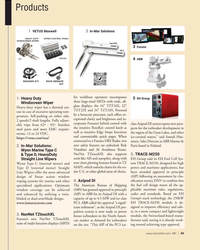 )
April 2024 - Marine News page: 43
)
April 2024 - Marine News page: 43Products 1 2 VETUS Maxwell In-Mar Solutions 3 Furuno ABB 4 for workboat operators encompasses EH Group 1. Heavy Duty 5 three large-sized MFDs with wide, all- Windscreen Wiper glass displays: the 16” TZT16X, 22” Heavy-duty wiper has a thermal cut- TZT22X and 24” TZT24X. Powered out in
-
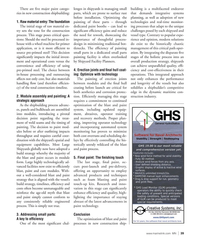 )
April 2024 - Marine News page: 39
)
April 2024 - Marine News page: 39There are ? ve major paint catego- lenges in shipyards is managing small building is a multifaceted endeavor ries in new construction shipbuilding: parts, which are prone to surface rust that demands integrative systems before installation. Optimizing the planning, as well as adoption of new 1.
-
 )
April 2024 - Marine News page: 35
)
April 2024 - Marine News page: 35in 10 years’ time, Crowely expects the eWolf will have saved 178 tons of nitrogen oxides, 2.5 tons of diesel particulate matter and 3,100 metric tons of carbon. Receiving a charge While eWolf is already in San Diego, ready to go, its of? - cial entry into service has been put on a short hold as it awaits
-
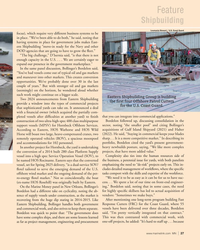 )
April 2024 - Marine News page: 27
)
April 2024 - Marine News page: 27Feature Shipbuilding Loumania Stewart / U.S. Coast Guard focus), which require very different business systems to be in place. “We’ve been able to do both,” he said, noting that having systems in place for government jobs makes East- ern Shipbuilding “move-in ready for the Navy and other DOD agencies
-
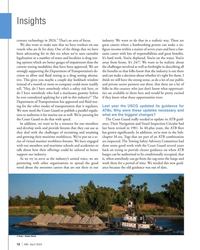 )
April 2024 - Marine News page: 12
)
April 2024 - Marine News page: 12Insights century technology in 2024.” That’s an area of focus. industry. We want to do that in a realistic way. These are We also want to make sure that we have workers on our great careers where a hardworking person can make a six- vessels who are ? t for duty. One of the things that we have ? gure
